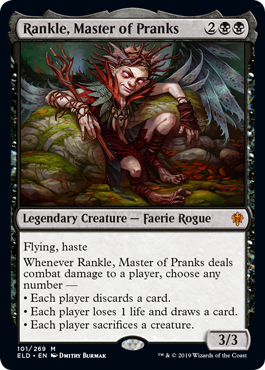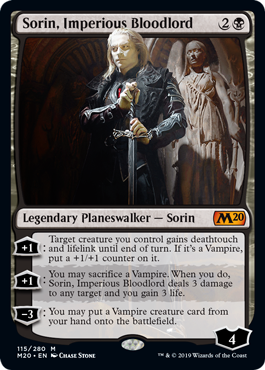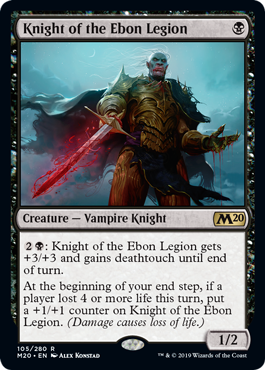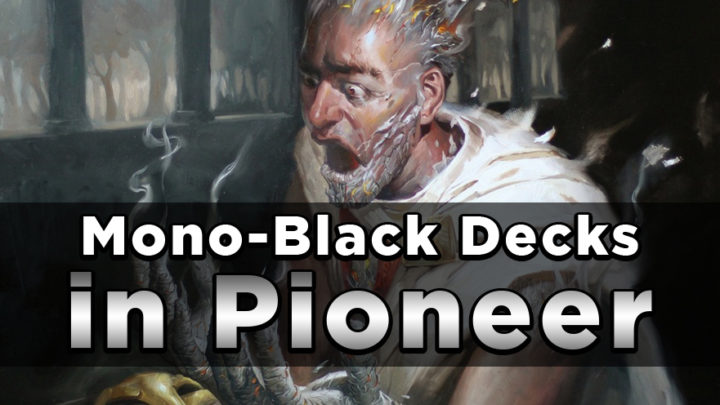Mono-Black is one of Pioneer’s oldest archetypes, and has continued to be a mainstay. It’s an aggressive strategy that utilizes cheap, resilient creatures like Bloodsoaked Champion and Dread Wanderer to get the ball rolling, while using the most powerful interaction spells in the format in Thoughtseize and Fatal Push to drive your threats home. Just in case your smaller creatures don’t get the job done, you have the hasty, might-as-well-be-Planeswalker in Rankle, Master of Pranks and Spawn of Mayhem to clean up.
Card Kingdom’s own Chris VanMeter played the deck in our most recent CK Pioneer stream:
Watch Highlight: CK Pioneer – Let’s get Dark from CardKingdom on www.twitch.tvSince Mono-Black became an established archetype in Pioneer, we’ve seen constant innovations and improvements to the archetype. One of the standout variants has been Vampires, inspired in large part by Sorin, Imperious Bloodlord. Building around Sorin ends up being quite easy, mostly because the format has just enough vampires to make the deck work.
While the shift from Mono-Black to Vampires is fairly easy to make, the deck behaves much, much differently. Today, we’ll be talking about the differences.
Mono-Black Aggro

Creatures (28)
4 Scrapheap Scrounger
4 Bloodsoaked Champion
4 Dread Wanderer
4 Knight of the Ebon Legion
3 Mogis’s Marauder
4 Murderous Rider
2 Spawn of Mayhem
3 Rankle, Master of Pranks
Lands (24)
15 Swamp
4 Castle Locthwain
4 Mutavault
1 Urborg, Tomb of Yawgmoth
Spells (8)
4 Fatal Push
4 Thoughtseize
Sideboard (15)
2 Aethersphere Harvester
2 Damping Sphere
4 Leyline of the Void
1 Doom Blade
1 Noxious Grasp
1 Ultimate Price
2 Shadowspear
2 Agonizing Remorse
Mono-Black behaves like a tempo deck, using cheap interaction to push through damage from early threats. Your threats may not be the bulkiest or the sturdiest, but they are sticky. Many of your one-drops will come back to the battlefield one way or another, which makes up for how often they get outclassed. The bigger threats have multiple purposes that check all the boxes: Removes a threat, has evasion, or is otherwise hard to handle the turn it comes down.
This deck, at its baseline, will always be powerful by nature in Pioneer. You’ll want to play this deck if you’re looking to attack with pesky threats that refuse to go away. You aren’t the fastest deck, but your resilience is among the best. Chris VanMeter illustrates that well in this come-from-behind win.
Watch Highlight: CK Pioneer – Let’s get Dark from CardKingdom on www.twitch.tvVampires
Vampires plays more like a Jund deck. By nature, it’s a value-based archetype that wants to see a bunch of cards and leverage that card advantage. Sorin and Champion of Dusk are both key to this strategy, and this deck leans hard on them.
By playing Vampires, you’re conceding a hefty amount of potential early momentum in exchange for additional card advantage. This is important because it directly affects how you play each match-up. The U/W Control match-up, for example, is much better as Mono-Black Aggro than as Vampires, while your Sultai Delirium match-up would be better as Vampires compared to Aggro.
I cannot emphasize this enough: You must understand the nature of each deck before making a decision on which to play.

Creatures (23)
4 Champion of Dusk
4 Dusk Legion Zealot
4 Gifted Aetherborn
4 Knight of the Ebon Legion
4 Murderous Rider
3 Kalitas, Traitor of Ghet
Planeswalkers (4)
4 Sorin, Imperious Bloodlord
Lands (24)
15 Swamp
4 Castle Locthwain
4 Mutavault
1 Urborg, Tomb of Yawgmoth
Spells (9)
4 Fatal Push
1 Grasp of Darkness
4 Thoughtseize
Sideboard (15)
2 Aethersphere Harvester
4 Leyline of the Void
1 Eat to Extinction
3 Grasp of Darkness
2 Davriel, Rogue Shadowmage
2 Duress
1 Infinite Obliteration
Key differences and focal points
As we mentioned earlier, Mono-Black Aggro will perform better against anything that takes a while to get their wheels going. Decks like U/W Control, Sultai Delirium, and Niv to Light are what you want to see. With Vampires, you generally want to play against more aggressive decks, and decks that are soft to Planeswalkers. Dimir Inverter, Mono-Red, and Mono-Black Aggro are all more vulnerable to Vampires.
The decks also differ in composition, and not just because one of them is tribal. Mono-Black Aggro relies on recursive one-drops, such as Gutterbones, Dread Wanderer, and Bloodsoaked Champion. Your plan is to hit the ground running in the early game and then use your heavy hitters to finish things off. Knight of the Ebon Legion is the only commonality between the two decks here, as it’s easily the best one-drop black has access to.

Of course, Knight of the Ebon Legion is a vampire, but it’s not the only card that goes up in value in the tribal build. Mutavault is way more valuable in Vampires because it’s every creature type. You can pumping it or fling it with Sorin, draw an extra card off of Champion of Dusk, or get an extra Sanctum Seeker trigger. Kalitas gets much better in vampires, too, because you can sacrifice any of your creatures to it.
The decks can share several pieces of interaction. (Not surprising, given that black has some great options in Pioneer.) Grasp of Darkness deals with Torbrans and Rankles, Drag to the Underworld answers anything, and Thoughtseize is the best card in Pioneer.
Other Options
Of note, you can certainly deviate from these general game plans. Mono-Black Aggro does not have to play twelve one-drops. You can opt to go bigger with more copies of Rankle, Spawn of Mayhem, or Kalitas, Traitor of Ghet. Similarly, Vampires doesn’t have to just play vampires. It’s considerably harder to deviate here, since every vampire you cut hurts Sorin by quite a bit, but Rankle is so good at stripping resources that it’s worth considering.

A more ambitious route is splashing white for Blood Baron of Vizkopa. Blood Baron is the best slam dunk in any black mirror or red match-up, as well as a strong way to end the game against slower decks. You can get down to ten life pretty quickly by activating Castle Locthwain, and aggressively pushing your life down will help make it a 10/10 in no time.
Hard to Go Wrong
While these Mono-Black builds have different strengths and weaknesses, they’re both strong choices for the Pioneer field. It’s very hard to go wrong with a Thoughtseize deck already, and coupling Thoughtseize with pressure or value will always be worth playing! I recommend trying both of these decks and seeing which one best fits your local meta.

Anthony Lowry is a high level competitor in several games, and Magic is no exception. His newfound passion for deckbuilding has reignited his drive to compete and test his skill against the best.

